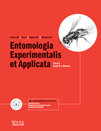Ver ítem
- xmlui.general.dspace_homeCentros e Institutos de InvestigaciónCICVyA. Centro de Investigación en Ciencias Veterinarias y AgronómicasInstituto de GenéticaArtículos científicosxmlui.ArtifactBrowser.ItemViewer.trail
- Inicio
- Centros e Institutos de Investigación
- CICVyA. Centro de Investigación en Ciencias Veterinarias y Agronómicas
- Instituto de Genética
- Artículos científicos
- Ver ítem
Response of the fruit fly parasitoid Diachasmimorpha longicaudata to host and host‐habitat volatile cues
Resumen
Chemical information is crucial to insect parasitoids for successful host location. Here, we evaluated the innate response of Diachasmimorpha longicaudata (Ashmead) (Hymenoptera: Braconidae), a fruit fly larval parasitoid, to cues from host and host habitat (i.e., fruit infested with host larvae). We first assessed the preference of female parasitoids between oranges infested with Ceratitis capitata (Wiedemann) (Diptera: Tephritidae) and non‐infested
[ver mas...]
Chemical information is crucial to insect parasitoids for successful host location. Here, we evaluated the innate response of Diachasmimorpha longicaudata (Ashmead) (Hymenoptera: Braconidae), a fruit fly larval parasitoid, to cues from host and host habitat (i.e., fruit infested with host larvae). We first assessed the preference of female parasitoids between oranges infested with Ceratitis capitata (Wiedemann) (Diptera: Tephritidae) and non‐infested fruit. Females were highly attracted towards infested oranges on the basis of volatile chemical cues. After this initial experiment, we aimed at revealing the potential sources of volatile cues present in an infested fruit. To this end, we considered five potential sources: (1) punctured fruit; (2) fly feeding, frass, or host‐marking pheromone deposited on the orange surface; (3) larval activity inside the fruit; (4) the larvae themselves; and (5) fungi associated with infestation of oranges. Habitat cues associated with host activity and those produced by rotten oranges or oranges colonized by fungi were highly attractive for female wasps, whereas odours associated with the activity of the adults on the surface of the fruit, and those released by the fruit after being damaged (as happens during fruit fly egg‐laying) were not used as cues by female parasitoids. Once the female had landed on the fruit, direct cues associated with larval activity became important although some indirect signals (e.g., products derived from larval activity inside the fruit) also increased host searching activity. Our findings indicate that naïve D. longicaudata uses chemical cues during host habitat searching and that these cues are produced both by the habitat and by the host larvae.
[Cerrar]

Autor
Segura, Diego Fernando;
Viscarret, Mariana Mabel;
Ovruski Alderete, Sergio Marcelo;
Cladera, Jorge Luis;
Fuente
Entomologia Experimentalis et Applicata 143 (2) : 164-176 (May 2012)
Fecha
2012-05
Editorial
Wiley
ISSN
0013-8703
1570-7458
1570-7458
Formato
pdf
Tipo de documento
artículo
Palabras Claves
Derechos de acceso
Restringido
 Excepto donde se diga explicitamente, este item se publica bajo la siguiente descripción: Creative Commons Attribution-NonCommercial-ShareAlike 2.5 Unported (CC BY-NC-SA 2.5)
Excepto donde se diga explicitamente, este item se publica bajo la siguiente descripción: Creative Commons Attribution-NonCommercial-ShareAlike 2.5 Unported (CC BY-NC-SA 2.5)

